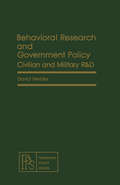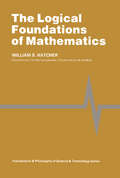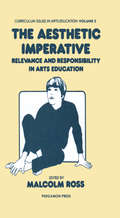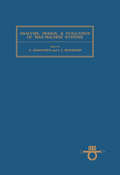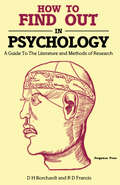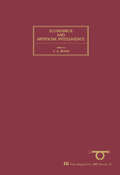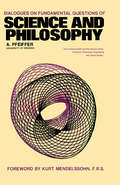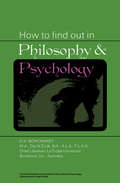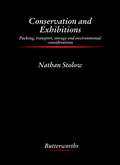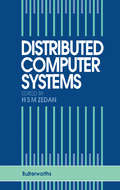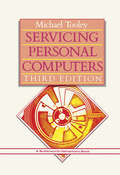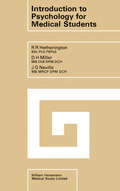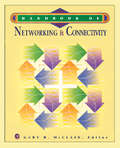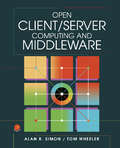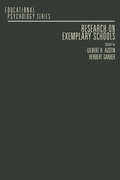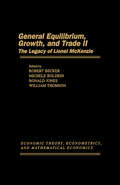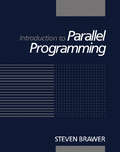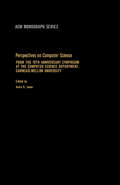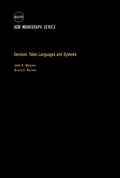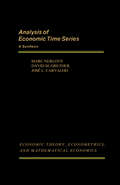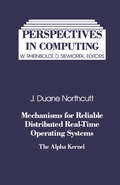- Table View
- List View
Behavioral Research and Government Policy: Civilian and Military R&D
by David MeisterBehavioral Research and Government Policy: Civilian and Military R&D explains the influence that the government have on research and development in the field of behavioral science. The book explores the different aspects in conducting a research with the main focus on the sponsor of the study. The book is the second part of a journal series titled International Reviews in Aerosol Physics and Chemistry. The text offers significant understanding of the methods employed to develop a theory for thermophoretic and diffusiophoretic forces acting on spheres in the range from free molecules to continuum behavior. The book explores the mathematical solution for the kinetic model of the coagulation equation. Another topic of interest is the means to estimate size dispersal function for clouds of particles undergoing collision. The text can be a useful tool for practicing scientists and to graduate students in physics, meteorology, geophysics, physical chemistry, environmental science, medicine, chemical engineering, and aerospace engineering.
The Logical Foundations of Mathematics: Foundations and Philosophy of Science and Technology Series
by William S. HatcherThe Logical Foundations of Mathematics offers a study of the foundations of mathematics, stressing comparisons between and critical analyses of the major non-constructive foundational systems. The position of constructivism within the spectrum of foundational philosophies is discussed, along with the exact relationship between topos theory and set theory.Comprised of eight chapters, this book begins with an introduction to first-order logic. In particular, two complete systems of axioms and rules for the first-order predicate calculus are given, one for efficiency in proving metatheorems, and the other, in a "natural deduction" style, for presenting detailed formal proofs. A somewhat novel feature of this framework is a full semantic and syntactic treatment of variable-binding term operators as primitive symbols of logic. Subsequent chapters focus on the origin of modern foundational studies; Gottlob Frege's formal system intended to serve as a foundation for mathematics and its paradoxes; the theory of types; and the Zermelo-Fraenkel set theory. David Hilbert's program and Kurt Gödel's incompleteness theorems are also examined, along with the foundational systems of W. V. Quine and the relevance of categorical algebra for foundations.This monograph will be of interest to students, teachers, practitioners, and researchers in mathematics.
Business and the Middle East: Threats and Prospects
by Robert A. Kilmarx Yonah AlexanderBusiness and the Middle East: Threats and Prospects studies the political security condition in the Middle East and its implications for business in the 1980s. This book is divided in nine chapters, wherein the first chapter discusses the religious environment in the Middle East. This topic is followed by an overview of political and security assessment and by a discussion on the strategic, economic, and political assessment of businesses in Egypt. The economies and negotiations with the US of the Middle East are then examined. The last two chapters explain the multinationals and Arab economic development and the assessment of corporate vulnerability. This text will be invaluable to experts and students in the field of economics, business administration, and management, as well as to historians and other academicians interested in the economy of the Middle East.
The Aesthetic Imperative: Relevance and Responsibility in Arts Education
by Malcolm RossThe Aesthetic Imperative: Relevance and Responsibility in Arts Education is a collection of papers that covers various concerns in assessment in the context of arts education. In the first chapters, the text examines the predicament of the arts. The next two chapters relate assessment in the context of esthetic education and evaluation in the arts. Chapter 4 talks about the assessment of esthetic developments in the visual mode. The fifth chapter details the importance of evaluating the quality of the test itself, while the sixth chapter covers the conflict between schools and art education. In Chapter 7, the book talks about treating English as an art. The eighth chapter discusses the relevance of art in education, while the ninth chapter provides a conclusive discussion on art education. The text will be of great interest to readers who are concerned with the status of art as part of a school curriculum.
Analysis, Design and Evaluation of Man – Machine Systems: Proceedings of the IFAC/IFIP/IFORS/IEA Conference, Baden-Baden, Federal Republic of Germany, 27-29 September 1982
by G. Johannsen J. E. RijnsdorpAnalysis, Design, & Evaluation of Man-Machine Systems presents an examination of the construction and application of a combined network and production systems model. It discusses the computer simulation and experimental results of a fuzzy model of driver behavior. It addresses the ergonomic aspects of working places in control rooms. Some of the topics covered in the book are the control and supervision of the eurelios solar power plant; computer aided control station with coloured display for production control; dynamic and static models for nuclear reactor operators; ironies of automation; and theory and validation of model of the human observer and decision maker. The operation simulation for the evaluation and improvement of a medical information system are fully covered. An in-depth account of an online information retrieval through natural language is provided. The control of input variables by head movements of handicapped persons is completely presented. A chapter is devoted to a graphical hardware description language for logic simulation programs. Another section focuses on the symbiotic, knowledge-based computer support systems. The book can provide useful information to computer programmers, engineers, students, and researchers.
How to Find Out in Psychology: A Guide to the Literature and Methods of Research
by D. H. Borchardt R. D. FrancisHow to Find Out in Psychology: A Guide to the Literature and Methods of Research is a research guidebook in psychology. The book is comprised of 11 chapters that address concerns in psychological research. The text first covers the concept of psychology and its major theories, and then proceeds to tackling bibliographic aids for research in psychology. The next series of chapters details the methodologies in researching and presenting. The last chapters discuss the professional matters in psychology. The book will be of great use to students, researchers, and practitioners of behavioral science.
Economics and Artificial Intelligence: Proceedings of the IFAC/IFORS/IFIP/IASC/AFCET Conference, Aix-en-Provence, France, 2—4 September 1986
by Jean-Louis RoosEconomics and Artificial Intelligence documents the proceedings of the IFAC/IFORS/IFIP/IASC/AFCET Conference held in Aix-en-Provence, France on September 2-4, 1986.This book discusses the design of intelligent dialogue in D.S.S. qualitative modeling of economic studies; basic propositions for intelligent systems design methods; and expert systems for confirmatory data analysis. The artificial intelligence for transaction cost economizing; knowledge-based evaluation of strategic investments; and reasoning system for the guidance of technological transfer are also elaborated. This text likewise covers the A.I. impacts on the process of the division of labor; using automated techniques to generate expert systems for R&D project monitoring; and intelligent support to decision making process.This compilation is a good reference for students and researchers conducting work on the nature of economics and artificial intelligence.
Dialogues on Fundamental Questions of Science and Philosophy: The Commonwealth and International Library: Dialogues on Fundamental Questions of Science and Philosophy
by A. PfeifferDialogues on Fundamental Questions of Science and Philosophy presents a compilation of dialogues concerning the basic questions of science and philosophy. This book discusses the relationship between philosophy and science.Organized into two parts encompassing 10 chapters, this book begins with an argument that reality can be recognized objectively, but not that there is a conflict between science and faith. This text then examines the invalidity of the causality principle in the microworld of the elementary particle and by the lack of individual identity of the particles. Other chapters consider the argument that philosophy should also make use of scientific methods. This book discusses as well the extended version of the biogenetical law of Haeckel, which is also valid for the progress of the human perceptive faculty. The final chapter deals with the argument that the idea of good as a tenet for practical actions is religious in character.This book is a valuable resource for readers who are interested in the fields of science and philosophy.
How to Find Out in Philosophy and Psychology: The Commonwealth and International Library: Library and Technical Information Division
by D. H. BorchardtHow to Find Out in Philosophy and Psychology is a guidebook for accessing various philosophical and psychological literatures. The coverage of the text includes dictionaries, journals, encyclopedias, and handbooks. The selection also covers various kinds of bibliographies, such as national, general retrospective, and bibliographies of specialized fields. The last chapter tackles various philosophical and psychological organizations. The book will be of great use to students who needs to have access to various philosophical and psychological materials.
Conservation and Exhibitions
by VASTAConservation and Exhibitions: Packing, Transport, Storage, and Environmental Considerations presents the theory and practice in exhibitions conservation. The book aims to promote better conservation practices and less wear and tear of works of art. Topics discussed in the book include conservation principles, examining and reporting a work of art's structural stability, preparation and handling, and storage. Traditional and newer packing techniques, case and container design and construction, transportation modes, strategies and equipment, and loan agreements and insurance are also covered in detail.Conservator practitioners, exhibition organizers, technicians, and transportation specialists will find the book very useful.
Distributed Computer Systems: Theory and Practice
by H. S. ZedanDistributed Computer Systems: Theory and Practice is a collection of papers dealing with the design and implementation of operating systems, including distributed systems, such as the amoeba system, argus, Andrew, and grapevine. One paper discusses the concepts and notations for concurrent programming, particularly language notation used in computer programming, synchronization methods, and also compares three classes of languages. Another paper explains load balancing or load redistribution to improve system performance, namely, static balancing and adaptive load balancing. For program efficiency, the user can choose from various debugging approaches to locate or fix errors without significantly disturbing the program behavior. Examples of debuggers pertain to the ada language and the occam programming language. Another paper describes the architecture of a real-time distributed database system used for computer network management, monitoring integration, as well as administration and control of both local area or wide area communications networks. The book can prove helpful to programmers, computer engineers, computer technicians, and computer instructors dealing with many aspects of computers, such as programming, hardware interface, networking, engineering or design.
Protecting Information on Local Area Networks
by James A SchweitzerProtecting Information on Local Area Networks presents the various types of networks and explains why they are being expanded at such a rapid pace. This book considers how management can gain control of the valuable network-services information resources generally available.Organized into three parts encompassing seven chapters, this book begins with an overview of the various networks and their operations. This text then discusses the appropriate management actions to ensure some control over the use of networks and the business information resource. Other chapters consider the management rationale for network information security and explain the development of a company information network security policy. This book discusses as well security or network-connected personal computers. The final chapter deals with a number of major vulnerabilities of information when communicated or processed on network-connected personal computers.This book is a valuable resource for research scientists, technical security specialists, information systems specialists, and systems administrators.
Servicing Personal Computers
by Michael TooleyServicing Personal Computers, Third Edition focuses on processes, techniques, and methodologies involved in servicing personal computers. The publication first elaborates on microcomputer systems and test equipment. Discussions focus on data communications test equipment, choosing test gear, microprocessors, random access memory, parallel input and output, memory mapped input and output, and raster scan displays. The manuscript then takes a look at fault diagnosis and tape and disk drives. Concerns include disk and cassette drives, initial check procedure, testing the CPU board, and fault finding on an RS-232 interface. The book examines printers and monitors, servicing the IBM PC and compatibles, and servicing 68000-based microcomputers. Topics include fault finding 68000-based micromputers, Apple Macintosh, 68000 based systems, 68030 and 68040, support devices, useful memory locations, 8086 and 8088 microprocessors, and user and supervisor modes. The publication is a vital source of data for computer engineers and researchers interested in servicing personal computers.
Introduction to Psychology for Medical Students
by R. R. Hetherington D. H. Miller J. G. NevilleIntroduction to Psychology for Medical Students deals with general psychology aimed for medical undergraduate students. The book discusses psychology and its relevance to medicine, particularly on the relation of the mind and the treatment of physical diseases. The authors explain perceiving and imagining; and how perception is dependent on past experience or learning, and the effects of motivation and of mood on perception. The authors also discuss abstract and concrete thinking, emotional use of words, unconscious thinking, creative thinking, learning, and remembering. The unconscious process of forgetting of unwelcome memories is repression, while consciously trying to forget them is suppression. The authors also explain normal conflict, frustration, and reaction to stress including the physical aspects of emotions causing increases in blood pressure, in adrenaline flow, or in blood glucose level. The authors also discuss the hypnotic states, individual susceptibility, the induction of hypnotic states, and their clinical applications. This book is intended for medical undergraduate students, as well as to general readers interested in psychology and human behavior.
Handbook of Networking & Connectivity
by Gary R. McClainHandbook of Networking & Connectivity focuses on connectivity standards in use, including hardware and software options. The book serves as a guide for solving specific problems that arise in designing and maintaining organizational networks.The selection first tackles open systems interconnection, guide to digital communications, and implementing TCP/IP in an SNA environment. Discussions focus on elimination of the SNA backbone, routing SNA over internets, connectionless versus connection-oriented networks, internet concepts, application program interfaces, basic principles of layering, protocols and services, application layer, and conformance testing. The book then takes a look at integrated services digital network, an overview of the synchronous optical network, and X.25 and worldwide networking.The publication ponders on Metropolitan Area Networks (MAN), an overview of the switched multimegabit data service, and Ethernet/802.3 and Token Ring/802.5. Topics include Ethernet versus token ring, Ethernet/802.3, customer network management, MAN conception and technology, and SMDS specifications and sources and interface protocol. The selection is a vital source of data for systems professionals and researchers interested in networking and connectivity.
Open Client/Server Computing and Middleware
by Alan R. Simon Tom WheelerOpen Client/Server Computing and Middleware provides a tutorial-oriented overview of open client/server development environments and how client/server computing is being done.This book analyzes an in-depth set of case studies about two different open client/server development environments—Microsoft Windows and UNIX, describing the architectures, various product components, and how these environments interrelate. Topics include the open systems and client/server computing, next-generation client/server architectures, principles of middleware, and overview of ProtoGen+. The ViewPaint environment, ProtoView screen manager, SQLView visual database access, and ProtoView WinControl library are also elaborated. This text likewise covers the interaction with db-UIM/X, widgets and building interfaces, network object toolkit, and integration of cross-platform components.This publication is suitable for computing professionals and researchers interested in open client/server computing.
Recent Publications in the Social and Behavioral Sciences: The ABS Guide 1968 Supplement
by Unknown AuthorRecent Publications in the Social and Behavioral Sciences presents a guide to books, articles, some government reports, and a few pamphlets and unbound items about the theory; methodology; the principal areas of investigation and areas of investigation of potential reward; and about the role of the social sciences in contemporary society. The book provides a list of cited periodicals, bibliography, and title and subject indices. The text also covers a bibliography of special issues of The Americal Behavioral Scientist. The book will be useful to behavioral scientists, psychologists, and psychiatrists.
Research on Exemplary Schools
by Gilbert R. Austin Herbert GarberResearch on Exemplary Schools covers significant research works on effective school learning, with particular emphasis on identifying and analyzing a student's abilities and characteristics on the assumption that student learning was primarily determined by differences in individual potential and needs. The information provided is derived from the assumption that the characteristics of the school learning environment may explain the extent to which students master the outcomes desired from the school teaching-learning experience.This text is organized into three parts encompassing 10 chapters. Part I reviews the history of the exemplary schools research movements and the research findings, as well as policy implications concerning the relationships between private and public schools education, both Catholic and nonsectarian. Part II describes the methods for identifying exemplary schools, school climate, and the roles of the teacher and the school principal. Part III describes the policy issues emerging from effective schools research. This part also provide some critical thoughts on the movement from the perspective of an educational psychologist whose specialties are educational measurement and instructional design. This book will prove useful to researchers and practitioners who wish to improve the outcomes of all students in their schools.
General Equilibrium, Growth, and Trade II: The Legacy of Lionel McKenzie
by Robert Becker Michele Boldrin Ronald JonesGeneral Equilibrium, Growth, and Trade, Volume II: The Legacy of Lionel McKenzie presents the impact of Lionel McKenzie's contributions on modern economics. This book discusses McKenzie's researches that are relevant in applied economic fields, including general equilibrium, optimal growth, and international trade.Organized into three parts encompassing 24 chapters, this volume begins with an overview of the existence of competitive equilibrium in an economy with a finite number of agents and commodities. This text then presents two analyses that are basically responses to criticism of the development of real indeterminacy. Other chapters consider McKenzie's assumption of irreducibility, which plays a significant role in showing how compensated equilibria will be uncompensated equilibria because agents have cheaper net trade vectors in their feasible sets. This book discusses as well some properties of competitive equilibria for dynamic exchange economies with an infinite horizon and incomplete financial markets.This book is a valuable resource for economists and economic theorists.
Introduction to Parallel Programming
by Steven BrawerIntroduction to Parallel Programming focuses on the techniques, processes, methodologies, and approaches involved in parallel programming. The book first offers information on Fortran, hardware and operating system models, and processes, shared memory, and simple parallel programs. Discussions focus on processes and processors, joining processes, shared memory, time-sharing with multiple processors, hardware, loops, passing arguments in function/subroutine calls, program structure, and arithmetic expressions. The text then elaborates on basic parallel programming techniques, barriers and race conditions, and nested loops. The manuscript takes a look at overcoming data dependencies, scheduling summary, linear recurrence relations, and performance tuning. Topics include parallel programming and the structure of programs, effect of the number of processes on overhead, loop splitting, indirect scheduling, block scheduling and forward dependency, and induction variable. The publication is a valuable reference for researchers interested in parallel programming.
Perspectives on Computer Science: From the 10th Anniversary Symposium at the Computer Science Department, Carnegie-Mellon University
by Anita K. JonesPerspectives on Computer Science provides information pertinent to the fundamental aspects of computer science. This book discusses the weaknesses frequently found in minicomputers.Organized into 12 chapters, this book begins with an overview of the technological, economic, and human aspects of the environment in which PDP–11 was designed and built. This text then examines the set of techniques for tree searching. Other chapters consider a tutorial on automatic planning systems, with emphasis given to knowledge representation issues. This book discusses as well the classical least-fixedpoint approach toward recursive programs and examines the interplay between time and space determined by a variety of machine models. The final chapter deals with some of the primary influences in contemporary programming language design, namely, programming methodology, program specification, verification, and formal semantic definition techniques.This book is a valuable resource for students and teachers. Computer science theoreticians and mathematicians will also find this book useful.
Human Information Processing: An Introduction to Psychology
by Peter H. Lindsay Donald A. NormanHuman Information Processing: An Introduction to Psychology aims to convey the excitement of modern experimental psychology to the beginning student. The book discusses the organization of auditory perceptions; neural information processing; and the theories of pattern recognition. The text also describes the visual system; the dimensions of vision; the auditory system; and the dimensions of sound. The neural basis of memory; transient memories; the structure of memory; and memory processes are also considered. The book further tackles language acquisition; the process of learning and cognitive development; problem solving; and decision making. The text also looks into motivation and the biochemical responses to stress. Psychologists and students taking psychology and related courses will find the book useful."
Decision Table Languages and Systems
by John R. Metzner Bruce H. BarnesACM Monograph Series: Decision Table Languages and Systems focuses on linguistic examination of decision tables and survey of the features of existing decision table languages and systems. The book first offers information on semiotics, programming language features, and generalization. Discussions focus on semantic broadening, outer language enrichments, generalization of syntax, limitations, implementation improvements, syntactic and semantic features, decision table syntax, semantics of decision table languages, and decision table programming languages. The text then elaborates on design implications, decision structure tables, spectrum of decision table use, and history of decision table programming. Topics include feature evaluation method, breadth of decision table applicability, and suggested design procedure. The book also takes a look at sequential test procedures and language references. The publication is a vital reference for researchers interested in decision table languages and systems.
Analysis of Economic Time Series: A Synthesis
by Marc Nerlove David M. Grether José L. CarvalhoAnalysis of Economic Time Series: A Synthesis integrates several topics in economic time-series analysis, including the formulation and estimation of distributed-lag models of dynamic economic behavior; the application of spectral analysis in the study of the behavior of economic time series; and unobserved-components models for economic time series and the closely related problem of seasonal adjustment.Comprised of 14 chapters, this volume begins with a historical background on the use of unobserved components in the analysis of economic time series, followed by an Introduction to the theory of stationary time series. Subsequent chapters focus on the spectral representation and its estimation; formulation of distributed-lag models; elements of the theory of prediction and extraction; and formulation of unobserved-components models and canonical forms. Seasonal adjustment techniques and multivariate mixed moving-average autoregressive time-series models are also considered. Finally, a time-series model of the U.S. cattle industry is presented.This monograph will be of value to mathematicians, economists, and those interested in economic theory, econometrics, and mathematical economics.
Mechanisms for Reliable Distributed Real-Time Operating Systems: The Alpha Kernel
by J. Duane NorthcuttMechanisms for Reliable Distributed Real-Time Operating Systems: The Alpha Kernel deals with the Alpha kernel, a set of mechanisms that support the construction of reliable, modular, decentralized operating systems for real-time control applications. An initial snapshot of the kernel design and implementation is provided.Comprised of seven chapters, this volume begins with a background on the Alpha operating system kernel and its implementation, followed by a description of the programming abstractions created for the Alpha kernel. The third chapter defines the client interface provided by the kernel in support of the given programming abstractions, while the fourth chapter focuses on the functional design of the kernel. The hardware on which the kernel was constructed, as well as the implications of this hardware on the design and implementation of the kernel, is also examined. The final chapter compares Alpha with other relevant operating systems such as Hydra, Cronus, Eden, Argus, Accent, and Locus.This book will appeal to computer scientists, systems designers, and undergraduate and graduate students of computer science.
